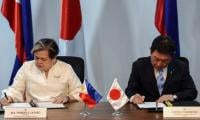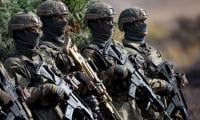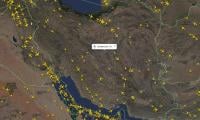Karachi and Kabul – violence-hit cities reshaped by migration
Karachi
As the two-day event “Caravanserai - Kabul in Karachi”, kicked off at a hotel, the attendees were indeed thankful to a breezy evening as all sat down to listen to engaging discussions as well as enjoy the traditional music at the end of day one.
The sessions, comprising speakers and participants from both Kabul and Karachi, presented both cities in a light that has a similar composition be it in the form of rich culture, language or even raging violence.
Moderated by Nazish Brohi, a session titled “The city and the city”, political economist Akbar Zaidi and journalist Ali Latifi explored the dynamics of Karachi and Kabul in relation to the diasporas, the cartography over time as well as the resilience found in the dwellers of both the cities who have suffered through violence.
Speaking about how identities are shaped by cities, be it by migrants or inhabitants, Zaidi said interestingly it was the Mohajirs who were alien to the city, swamped Karachi overnight and took over a part of Sindh.
He added that there had been waves of migrants ever since be it of Hazaras or Pukhtuns in 1960s or Seraikis or Baloch.
“After 1951 especially in the 1980s, it acquired a political identity which reflected the mood and aspiration of a social class. Migrants became anti-migrants - it was surprising to see that the Mohajir who came from a land far away from Karachi were against migrants who came from considerably nearby areas so there were these waves of migrants and multiple opposition toward these identities,” Zaidi observed.
“In the 1980s, a political identity, a hegemonic one, was claimed by the Urdu-speaking people and their political party. They opposed all other migrants and felt it was their right to determine how the city functioned and who was allowed in it but it was almost ironic that they were migrants themselves,” he reflected.
Latifi, LA Times journalist of Afghan origin, echoed Zaidi’s views and compared the situation with Kabul itself. He pointed out that whenever the issues - for instance about infrastructure - were discussed, the dwellers would say that the other settlers were responsible for the present conditions, though they themselves had arrived from other provinces after the actual Kabulese had left.
“This goes back to the classist idea that ‘I came from Kabul, I am originally from Kabul’ and the other came from Paktiya where there is war and poverty and we tend to forget that and comment ‘’why don’t they go back’’ and we forget that there is an actual war going on there in the rest of the country and the areas where there is not, there is no economy,” he explained.
Given that both cities have violent and bloody histories, Brohi asked what the rhetoric of resilience meant. Latifi responded that it had more to do with the idea of no choices.
“I left when I was young and didn’t see the war and there were people who literally grew up with it. Real resilience is clichéd and there is violence in Kabul and you never know, a bomb can go off any time, but there is no choice, their lives just go on. There is all there is to do,” lamented Latifi.
Zaidi, who said he never appreciated this term, stressed on the relationship of Karachi and its inhabitants: “Only people who don’t live in Karachi wonder how people in Karachi live and that’s the question thrown at Karachiites when they step out of the city but where else can they live. People who have lived in Karachi all their lives don’t think there is an alternative to the city.”
He said Karachi, which had its fair share of violence, had suffered through its spells perhaps even more violent than those in Peshawar:
“It has a longer history and different waves of violence, different types of violence. unlike say Talibanisation which had taken place in Afghanistan or the impact in Peshawar and other parts of Pakistan. Karachi should be proud of its indigenous violence which has not been exported and has got nothing to do with the Taliban, which is our own problem, we created it, we made it and we rooted it out, and any city which has a population of 22 million is bound to have different kinds of violence and accidents. It’s not that the people in Karachi are more violent it’s just the easy access to weapons and common urban problems are dealt with in a very violent way,” he opined.
“Violence becomes part of you and you don’t even know it is happening and I don’t think it’s just resilience, it’s just breathing the air of the sea and breathing the air of violence,” he added.
Shedding light on the political and social mapping of the city, Latifi said with the city divided into areas confined for a particular group of people usually belonging to the political establishment, the people tend to become cut off.
However if Karachi comes to a halt, as Zaidi pointed out, the whole lot gets paralysed. “There are very few people who live on this side of the bridge know what happens on the other side but when that side closes down this side is affected too so there is a relationship between spaces, the relationship of fear and violence. The sahibs and begums who are dependent on workers coming from different parts of the city realise that there are areas like Landhi, Korangi and Orangi which have caught political fire,” he noted. “Karachi is a city which makes the elite uncomfortable because of upward mobility and within a generation or two, people from far-flung areas have taken property which was ‘exclusive’ for one social class. People broke the divide and this is not celebrating or democratising violence rather it’s just the consequences and this gives opportunity to different social divisions,” he added.
Of objectivity
In another session, “The Art of Story Telling” journalists Mohammad Hanif, Saba Imtiaz and Latifi narrated their experiences of working as foreign correspondents and reporting about the happenings in their own cities or countries.
Latifi said while it was perfectly acceptable to think that a journalist from Paris would not have any bias toward Mali, it was assumed that a reporter from Africa or Asia would harbour bias, and hence the reporters had to add nuance and objectivity. Nevertheless he believed in bringing all out sides of the picture. Referring to an incident when a French restaurant was attacked in a narrow alley in Kabul, he recalled how a man whose own house was destroyed called it a “whore house” and Latifi wrote it so, only to get negative criticism from many, hinting how people forget the greater damage.
Speaking about dissociation from the story, Imtiaz pointed out that indifference was what she felt many times not because of the story but because it was need of the profession. Latifi also added that many a time his stories would carry words “Islamist” and “militants”, terms he refrained from using, signalling the say of editors in the final work.
Mohammed Hanif, who admitted that he had been away from the field reporting, said while informing was the primary purpose of reporting earlier, now entertaining had also become one of the purposes.
The Caravanserai - Kabul in Karachi has been organised by MOBY and LAPIS in association with local organisations.
-
 Microsoft Secures Largest Ever Soil Carbon Credit Agreement Amid Data Centres Expansion
Microsoft Secures Largest Ever Soil Carbon Credit Agreement Amid Data Centres Expansion -
 Google Expands Gemini With Personal Intelligence
Google Expands Gemini With Personal Intelligence -
 Japan, Philippines Sign Defence Pacts As Regional Tensions Escalate
Japan, Philippines Sign Defence Pacts As Regional Tensions Escalate -
 ISS Crew Of Four Completes Medical Evacuation With Safe Splashdown Off California
ISS Crew Of Four Completes Medical Evacuation With Safe Splashdown Off California -
 Connor Storrie Reveals Why His Dad Hasn't Seen 'Heated Rivalry' Yet
Connor Storrie Reveals Why His Dad Hasn't Seen 'Heated Rivalry' Yet -
 Meghan Markle’s Biggest Challenge In UK Return As She Struggles To Control Narrative
Meghan Markle’s Biggest Challenge In UK Return As She Struggles To Control Narrative -
 Princess Beatrice, Eugenie Angry As King Charles Ends Their Financial Security
Princess Beatrice, Eugenie Angry As King Charles Ends Their Financial Security -
 Chase Infiniti Shares Her Working Experience With Leonardo DiCaprio
Chase Infiniti Shares Her Working Experience With Leonardo DiCaprio -
 Todd Bridges And Wife Bettijo B. Hirschi Separate After Three Years Of Marriage
Todd Bridges And Wife Bettijo B. Hirschi Separate After Three Years Of Marriage -
 Germany Sends Troops To Greenland Amid Rising Arctic Tensions
Germany Sends Troops To Greenland Amid Rising Arctic Tensions -
 Jonathan Quick, The New York Rangers Face Mounting Pressure As Losses Pile Up
Jonathan Quick, The New York Rangers Face Mounting Pressure As Losses Pile Up -
 Timothée Chalamet, Kylie Jenner Are Living Together In LA: Source
Timothée Chalamet, Kylie Jenner Are Living Together In LA: Source -
 Johnny Knoxville Net Worth: How The Actor Built A $50mn Fortune
Johnny Knoxville Net Worth: How The Actor Built A $50mn Fortune -
 Meghan Markle Hidden Agenda Behind Returning To UK Exposed
Meghan Markle Hidden Agenda Behind Returning To UK Exposed -
 Raptors Vs Pacers: Toronto Shorthanded With Key Players Ruled Out Due To Injuries
Raptors Vs Pacers: Toronto Shorthanded With Key Players Ruled Out Due To Injuries -
 Iran Flight Radar Update: Airspace Closure Extended Amid Heightened Tensions
Iran Flight Radar Update: Airspace Closure Extended Amid Heightened Tensions



